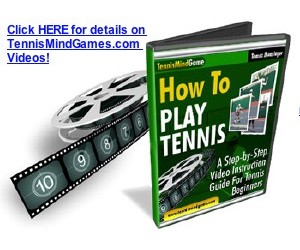August 2001 Article Turbo Tennis Archives:
Tennis Server
|

 |
It is often said that a tennis player is only as good as her/his second serve…and I couldn’t agree more. The second serve is the serve that has to go in the box, or a player will lose the point! There are no third serves. Quite often, I will see players who do practice their serves working on the first serve. They will be banging serves as hard and as flat as they can. Their hope, I guess, is to win the point with these "big guns." If you are a Venus Williams, Pete Sampras, Goran Ivanisevic, or Lindsey Davenport…you probably will win lots of points of the first serve…either by aces or out and out winners. But, most of us are mere mortals, and unfortunately, we are probably going to have to hit some second serves. Because the second serve is the last chance, it is the pressure serve. Yet, many players do not work on developing a second serve that is reliable. Unfortunately, for some of us, our second serve is nothing more than a three quarter paced first serve. These slow, flat second serves are rarely reliable, and are usually easy to read and to put away.
The two most common spin serves are the slice serve and the "kick" serve. The former of these two serves is most appropriate for grass and other fast surfaces where the ball is likely to skip and/or bounce low. The kick serve is the primary second serve used by most of the pros. It is good on every surface with, perhaps, the exception being grass. The slice serve has sidespin and curves as it moves in the air. It also travels in such a way that forces the ball to curve after the bounce. The kick serve is primarily a topspin serve but has a little sidespin associated with it, as well. It will bounce higher than first serves and on the ad court (when hit by righties) it will probably bounce to the right, which pulls the opponent out of court. I have had such success with my kick serve that I use it as both my first and second serve. I just vary the position of the first serve. The second serve is almost always going to the right-handed player’s backhand. Well, this month’s column is going to put you on your way to developing a great second serve. When you have confidence in your second serve, you will see that your first serve improves dramatically. Let’s begin with grip. For second serves, the continental, "hammer," and eastern backhand grips are the only grips that really impart spin. When I played a national tournament in Arizona, Peter Bronson (a well known, multiple gold ball, senior player) showed me that he could hit kick and slice serves with an eastern forehand grip (the grip he uses for all his serves). However, I don’t advise following his example. The continental, hammer and eastern backhand grips allow the wrist to bend or "break" at the moment of impact with the ball, and this is how one can generate dramatic. Here is the continental grip. Here is the eastern backhand grip.
Here is what the hammer grip looks like. Remember, the hammer grip is really a tight-fisted continental grip. It derives its name from its similarity to the way one would hold a hammer. Note that the blue areas on the racquet handles represent the top and sides of the racquet grip. The black areas are the bevels. For the slice serve, the continental or hammer grips are probably the best choice. For the kick serve, I truly think that the eastern backhand grip needs to be adopted, if you really want to impart spin. When hitting any spin serve, a closed or semi-closed stance works best. I try to teach my students to use the most closed stance possible (given their motions). Why? Well, a closed stance will automatically provide some shoulder rotation, which will help generate pace. Generally, if your front foot is pointing directly at the right net post (for righties) or left net post (for lefties) you are in proper stance. By the way, this "rule" applies to serving to either deuce or ad courts. The biggest variation in spin serves is the toss. Although some pros like Pete Sampras can hit any serve with the same toss, most of us need to alter the toss to achieve the right result. Now, I know many of you are saying…"Yes, but won’t that telegraph the serve to my opponent?" The answer is probably. But you know what? After a few games, a heady opponent has locked in on your serve patterns anyway. My thinking is that telegraphing is okay…if the desired spin is achieved.
Slice serves can be hit with lots of pace. On the deuce court, the righty’s slice serve can really pull an opponent out of court. I like to use this serve when I find my opponent hits his forehand with a big western grip. Likewise, the lefty has a great weapon when serving to the ad court if she/he uses the slice serve. In fact, I cannot imagine why any lefty would not really work on this serve. Its spin is so foreign to left handed and right handed players alike that free points are almost guaranteed. The finish of the slice serve is the same as it would be for the first serve that is hit hard and flat. The racquet should cross your body. Look at these examples. The kick serve is usually the serve that is most difficult for players to learn. Still, it is probably the single most important serve to have in your arsenal. Why? Well, almost every kick serve will drop in the box, and in such a manner that the opponent will usually not be able to tee off on it. Good kick serves land deep, and bounce high. If they have some sidespin to them…so much the better!!! Adopting the eastern backhand grip will make your kick serve easier to hit. If you look at some pros, they use a very severe, backhand grip for this serve. The toss with the kick serve is the most different and important aspect of the serve. You must toss the ball behind you. What do I mean by this? Well, if you are tossing the ball up and did not hit it, it would land behind your body…if you are tossing correctly for the kick serve. Now, I know this sounds crazy, but look at any pro that hits a great kick serve. You will notice that her/his back is arched significantly. This arch is necessary because of the toss. The idea is to hit up and hit away from your body when hitting the kick serve. I often give cues to my students like, "Toss the ball behind you." "Try to hit the bottom of the ball." "Try to hit the ball straight up." The finish in the kick serve is very different and distinctive. The racquet actually finishes on the same side of the body as the racquet arm and in a very pronated manner. It is difficult to describe, but a picture is worth a thousand words. Here are a couple thousand words… The final ingredient in any spin serve (whether slice or kick) is to break the wrist a bit at the moment of impact with the ball. When slice serving, the wrist should be broken in such a way as to facilitate the racquet head moving sideways along the back of the ball. When kick serving, try to break the wrist upward then downward. Each of these serves requires a little practice. I have taught students each of these serves in a one-hour lesson. Once you get the knack of each serve, it becomes simply a matter of practice before you can control the location, spin intensity and pace of each one. Practice these serves using targets. I do at least 100 serves everyday…apart from the serves I hit in match play or practice play. A word of caution. If you are using the continental or eastern backhand grips for the very first time when serving…don’t overdo the number of serves you hit in practice. Build up gradually. These grips will put a new strain on muscles, etc. By getting used to them a little at a time, you will save yourself unnecessary arm and shoulder discomfort. Not to worry, however. In time, the muscles, etc. will get used to the new grips/motions and you should experience no discomfort. Well, these are my thoughts on the second serve. If you can develop a reliable second serve, you will invariably become a tennis overdog!
1996 - 2002 | 2003 - Present
This column
is copyrighted by Ron Waite, all rights reserved. Questions and comments
about these columns can be directed to Ron by using this form.
Ron Waite is a certified USPTR tennis instructor who took up the game
of tennis at the age of 39. Frustrated with conventional tennis methods
of instruction and the confusing data available on how to learn the
game, Ron has sought to sift fact from fiction. In his seven years of
tennis, Ron has received USTA sectional ranking four years, has successfully
coached several NCAA Division III men's and women's tennis teams to
post season competition, and has competed in USTA National singles tournaments.
Ron has trained at a number of tennis academies and with many of the
game's leading instructors.
In addition to his full-time work as a professor at Albertus Magnus
College, Ron photographs ATP tour events for a variety of organizations
and publications. The name of his column, TurboTennis, stems from his
methods to decrease the amount of time it takes to learn and master
the game of tennis.
|



October 2022 Tennis Anyone: Patterns in Doubles by John Mills. September 2022 Tennis Anyone: Short Court by John Mills. |
 You will join 13,000 other subscribers in receiving news of updates to the Tennis Server along with monthly tennis tips from tennis pro Tom Veneziano.
You will join 13,000 other subscribers in receiving news of updates to the Tennis Server along with monthly tennis tips from tennis pro Tom Veneziano. 













